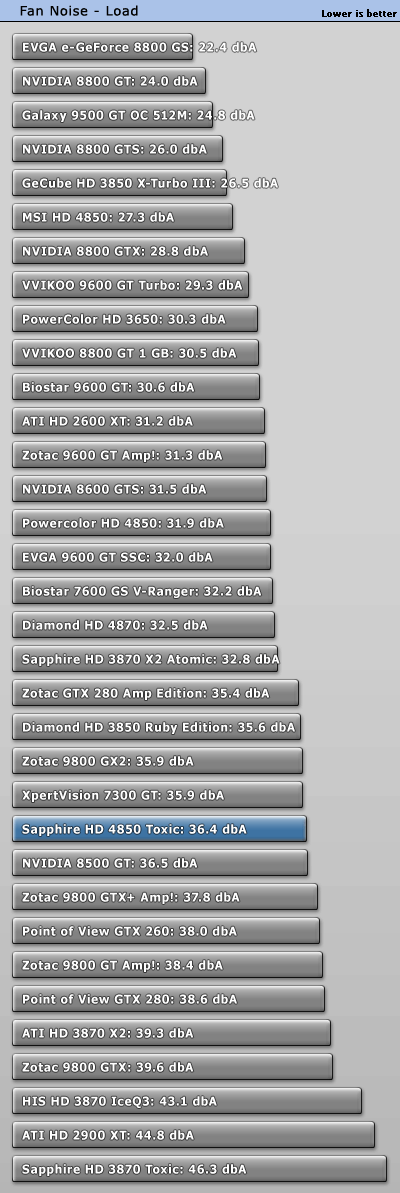 14
14
Sapphire HD 4850 Toxic 512 MB Review
Performance Summary, Perf/W, Perf/$ »Fan Noise
In the past years users would accept everything just to get more performance. Nowadays this has changed with people being more aware of the fan noise and power consumption of their graphic cards.In order to properly test the fan noise a card emits we are using a Bruel & Kjaer 2236 sound level meter (~$4,000) which has the measurement range and accuracy we are looking for.

The tested graphics card is installed in a system that is completely passively cooled. That is passive PSU, passive CPU cooler, passive cooling on the motherboard and Solid-State HDD.
This setup allows us to eliminate secondary noise sources and test only the video card. To be more compliant with standards like DIN 45635 (we are not claiming to be fully DIN 45635 certified) the measurement is conducted at 100 cm distance and 160 cm over the floor. The ambient background noise level in the room is well below 20 dbA for all measurements. Please note that the dbA scale is not linear, it is logarithmic. 40 dbA is not twice as loud as 20 dbA. A 3 dbA increase results in double the sound pressure. The human hearing is a bit different and it is generally accepted that a 10 dbA increase doubles the perceived sound level.
Sapphire has chosen to remove the temperature based fan control mechanism from their cooling solution. The fan will always run at the same speed, no matter if you run an idle system in Antarctica or under full load in the middle of the Saudi Desert. When asked, Sapphire replied that they "noticed that on many systems the problem is that the fan always starts and stops - at different temperatures. So we decided to always run at the same quiet fan speed".
This approach results in one of the noisiest cards under idle. When compared to the reference design HD 4850 the fan is 16.4 dbA noisier in idle - that's over 40x the sound pressure. Under load the margin gets smaller, yet the card cannot compare to the reference design when it comes to fan noise. However, the increased fan speed results in much lower temperatures and higher overclocking potential. Unfortunately power users won't be able to adjust the fan via any software. No matter what fan speed the card wants to run at the fan will always be around 1700 RPM.


May 10th, 2024 01:52 EDT
change timezone
Latest GPU Drivers
New Forum Posts
- AM5 boot times improve RADICALLY with memory context restore enabled (27)
- Ghost of Tsushima PC Port !!!! (22)
- Last game you purchased? (279)
- The TPU UK Clubhouse (24791)
- Kepler-Ada NVIDIA VBIOS Visualizer - opensource pattern for ImHex (0)
- Graphics card running at 8x 4.0 not 16x 4.0 (15)
- Only some humans can see refresh rates faster than others, I am one of those humans. (240)
- What's your latest tech purchase? (20490)
- Realtek Modded Audio Driver for Windows 10/11 - Only for HDAUDIO (5696)
- Flash VBIOS to turn RX 580 2048SP into RX 570 (26)
Popular Reviews
- CHERRY XTRFY M64 Pro Review
- Bykski CPU-XPR-C-I CPU Water Block Review - Amazing Value!
- Corsair iCUE Link RX120 RGB 120 mm Fan Review
- Corsair MP700 Pro SE 4 TB Review
- ThundeRobot ML903 NearLink Review
- Upcoming Hardware Launches 2023 (Updated Feb 2024)
- Finalmouse UltralightX Review
- AMD Ryzen 7 7800X3D Review - The Best Gaming CPU
- Sapphire Radeon RX 7700 XT Pure Review
- ASUS Radeon RX 7900 GRE TUF OC Review
Controversial News Posts
- Intel Statement on Stability Issues: "Motherboard Makers to Blame" (264)
- AMD to Redesign Ray Tracing Hardware on RDNA 4 (206)
- Windows 11 Now Officially Adware as Microsoft Embeds Ads in the Start Menu (169)
- NVIDIA to Only Launch the Flagship GeForce RTX 5090 in 2024, Rest of the Series in 2025 (144)
- Sony PlayStation 5 Pro Specifications Confirmed, Console Arrives Before Holidays (119)
- AMD's RDNA 4 GPUs Could Stick with 18 Gbps GDDR6 Memory (114)
- NVIDIA Points Intel Raptor Lake CPU Users to Get Help from Intel Amid System Instability Issues (106)
- AMD Ryzen 9 7900X3D Now at a Mouth-watering $329 (104)
